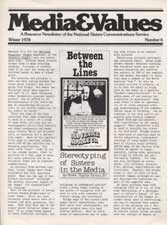How to Break the Stereotype
|
This article originally appeared in Issue# 6
|
Stereotyping is an insidious process. Mental categories and labels are necessary if we are to cope with the fast- paced world around us. Without stereotypes we would have to learn each day what fire-fighters do, how to behave at a funeral or what foods to eat for breakfast.
But categorizing is dangerous too. Stereotypes can become too rigid and when there is no room for growth the label becomes stifling, both for the individuals who are labeled and for the category itself. The challenge is to keep an open mind even for the most solid "givens." Absolutism is not a virtue in our constantly changing world.
For years the mental concept — 'nun' — was a victim of stereotyping. It had dozens of absolute givens included in it. Phyllis Giroux, SC, identifies many of them in her article Between the Lines: Stereotyping of Sisters in the Media. As a result of her analysis we see that even today after 15 years of religious renewal, many people still equate "nun" or even 'sister' with a person who wears a long dress, spends a lot of tine in church, lives a disciplined and sober life (except for an occasional outing at the circus), lives "behind walls", avoids the opposite sex, never questions anything or thinks for herself — in other words, is not quite human like everyone else.
We who are nuns know that this stereotype is, and in fact always was, superficial. But people perceive selectively through the screen of their own particular attitudes, values, beliefs and especially personal experience. No matter what we say, they hold the category and its properties intact.
To break out of an entrenched stereotype is not easy. Part of it involves knowing, or researching what others believed us to be in the past, what they believe now and what they see for the future. And we must do it systematically, by specific audiences that are important to us, e.g. college students, clergy, single career women, the business community, our own sisters, etc.
Then we must ask some basic questions of ourselves: What are! were specific properties of the "old" stereotype? Were they accurate then? Are they accurate now? What new properties of the mental category, "nun," have developed for us since Vatican II? What qualities seem to be missing or are different, between past, present and future?
It is only when we can identify this mix of old and new properties that we can approach the practical challenge of breaking out of the stereotype. It is only when we can articulate who we are (or are becoming), what we want to be known for, and who are the people we want to inform that we can begin the process of communicating, whether person-to- person or through mass media — brochures, newsletters, slide! tape shows, radio and television.
This is not to say we have to establish new absolutes to replace the old "givens." Perhaps the most profound change in religious life in our time is the recognition of plurality rather than uniformity, of evolutionary growth rather than unchangeable dictums. We only perpetuate the problems by replacing one stereotype with another. Remember the 60's when the focus was on guitars, blue-jeans and protest marches?
What we must work toward is an understanding of religious life as a responsible choice by mature persons who are motivated by an adult faith and a loving commitment. A "nun" is not a role; a nun is a person, a human being, a unique individual. That concept alone breaks all the stereotypes and opens the way for a re- cognition of religious congregations as communities of caring women, joined together to grow together, both individually and. in corporate response to the physical, emotional and spiritual needs of the evolving world we live in.
To break the stereotype as it is portrayed in the media, each congregation must do two things:
- Work-on its own specific articulation of what needs to be communicated to whom. I suggest this is the basic ongoing task of a communications/public relations office and involves consistent evaluation and long-range planning over a number of years.
- Evaluate carefully what is already being communicated in brochures, newsletters, slide shows. Is there information "between the lines" that perpetuates previous categories? For example the overuse of jargon words communicates elitism and non-relevance to the everyday world. Flowery theologizing promotes pietism. Posed and stilted pictures reinforce the image of formality while "snap-shoddy" slides only make the audience wonder whether we are serious about our lives and ministry. A good evaluation involves more than moving around pictures and headlines. Look deeply into the materials you prepare to see if the underlying concepts reflect the reality of your congregation.
Although this seems like a lot of work, an easy way to start is to support and participate in the National Sisters Communications Service. The N.S.C.S. offers a number of services, by subscription, to help congregations get a handle on the massive communications task that they face for the 1980's. Evaluations by tape, how-to resources to improve community materials, Media&Values, a job clearinghouse and a continuing flow of media materials related to religious communications are included in the basic congregational subscription. Long.-range communications analysis and consultation, photography services, workshops and seminars are also available for reasonable fees.
Although we have concentrated on the stereotyping of sisters in this review, similar problems abound for the priesthood and for religious congregations of men, especially of brothers. But resources and creative solutions are growing all the time as more congregations grapple with the problem and more women and men religious become involved in the communications ministry.
Breaking the stereotype, whether of sisters, priests or brothers will come not so much from worrying about past images but from an energetic and professional sharing of the day-to-day life and ministry of women and men serving the People of God today.



